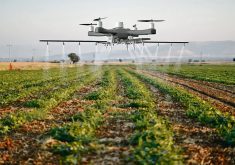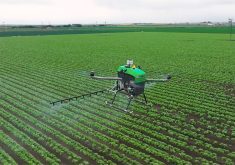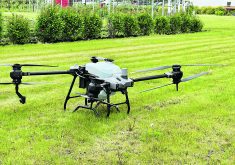A spraying expert says potential spray drift is a significant concern and payloads will likely be too small to be productive
Drone sprayers have been used in Pacific Rim agriculture for more than two decades, and they gained California certification four years ago. But do they have potential beyond the orchard gate?
Probably not, at least not in the foreseeable future, according to Tom Wolf, also known as the Nozzle Guy, in a recent post to his Sprayers101 Agrimetrix website.
Drone advocates say a drone can access problem topography or saturated soil where your self-propelled sprayer cannot go. True, but those are the areas you can’t farm anyway. Your tractor, seeder and combine won’t enter those areas, so why should your sprayer.
Read Also

Growing garlic by the thousands in Manitoba
Grower holds a planting party day every fall as a crowd gathers to help put 28,000 plants, and sometimes more, into theground
“I’ve been nervous about the prospect of pesticide application with drones,” Wolf said.
“My primary concern is around — you guessed it — spray drift.”
He said a drone payload is relatively small. With those small payloads, application volumes will be too low to have any sort of productivity.
“At those low volumes, a drone would be able to do perhaps one acre per load,” he said.
“While OK for spot spraying, it represents a serious productivity constraint for anything larger. There will be a push towards lower volumes, perhaps 0.5 to one gallons per acre. The only way these will provide sufficient coverage is with finer sprays, (American Society of Agricultural and Biotechnical Engineers) fine to very fine, with expected problematic effects on off-target movement and evaporation. These fine droplets are also more prone to the aerodynamic eccentricities of aircraft.”
Payloads for popular rotary unmanned aerial vehicles (there are others) capable of spraying crops are:
- Kray — 15 kilograms
- DJI Agras MG — 1 – 10 kg
- Yamaha RMax — 16 kg
- Yamaha Fazer — 24 kg
- Yamaha Fazer R — 32 kg
“A drone sprayer applying one gallon or less per acre means small droplets,” he said.
“Most of the drone atomizers are hollow cone nozzles or spinning discs that create a very fine spray. It doesn’t matter if you put Interlock in the tank. The fact is that you’re creating very fine droplets that are subject to drift.
“When the feds do a risk assessment to register a new fixed wing or helicopter for spraying, they are actually able to simulate the aerodynamic behaviour of each specific aircraft, and they can model what will happen with each new aircraft in terms of turbulence and spray pattern.
“When it comes to registering a drone, either fixed wing or rotary, they do not have that risk assessment. So before issuing any registrations, they may require that empirical data sets be developed for drift from various drones. We may end up with a drone-by-drone specific regulation. I don’t think they’re in anyway homogenous as a group of sprayers. Until this happens, application of any pesticide by drone remains illegal in Canada.”
Wolf said drones will go through the same risk assessment as when licensing a full size aerial sprayer. The regulators have a favorite aircraft in their computer model and they know it’s aerodynamic factors and how it affects spray, he added. It’s like a base line model, and the other aircraft are compared to it. However, none of this data is relevant to drones.
“Now we’re going to start all over from scratch with drones,” Wolf said.
“I don’t have a lot of hope that it’s going to go well. You have to ask if it’s even worth bothering with until the drones are bigger and have more capacity.
“I took a course last weekend to become a certified drone pilot. Instructors like Matt Johnson at M3 Aerial and Don Campbell at Headingly are serious about doing this right and doing it safely. But here’s my worry. I trust the aerial applicators who fly airplanes. They have plenty of training and they have a certificate, which they couldn’t get until they had a proven level of competence.
“If we open the drone world up to a bunch of guys who take a weekend drone course and then pass an online test, then we have a whole different calibre of applicators. I think there’s risk in that. Maybe they should be licensed applicators first and then become drone applicators second.”
On his website, Wolf said entering finer sprays into risk assessment models for conventional manned rotary wing aircraft proves that drone buffer zones must be much higher. That outcome will give pause to regulators.
Failure to control the movement of a spray is a problem. Furthermore, ultra-low volume (ULV) sprays can change the efficacy of some products. These will require new performance studies.
Because the drones available today don’t conform to a common design standard such as conventional fixed or rotary winged manned aircraft, each model may need its own study. Some will have rotary atomizers while others will use hollow cone hydraulic sprays. Some will have electrostatic charging and others may propose special adjuvants. Once data is assessed, there will likely be restrictions in flight height, flight speed, wind speed, spray quality, water volume, air temperature and relative humidity.
In the United States, Yamaha does not sell its drone helicopters. Instead, it deploy its own teams to make the applications. This way, it has assurance that only trained and experienced pilots use the technology.





















